The pandemic stopped almost everything except the movement of essentials. The truck drivers were at the core of the freight movement mission across the nation. Much before the pandemic struck the nation, India has already been grappling with the severe truck driver shortage. Industry experts suggest that pre-COVID, about one-third of the total truck population (*95 lakh trucks) were idling for the need of a driver.
With all migrants currently relocating to their homes, it is estimated that about two-thirds (*63 lakh+) of the trucks are idling at present. It will be a herculean task to get the drivers on the wheels again. Will the drivers return to their work anytime soon? Industry experts say that the fear of lockdown has gripped the drivers and moving freight across long distances (more than 1000 kilometers) with the same driver on the wheels will be a challenge. The drivers would now like to return to their home frequently.
What can the fleet operators do to recover from the crisis and resume the fleet operations to normalcy? The fleet operators may need to redefine their operating model.

A collaborative relay model
The fleet operators need to collaborate among them in several aspects. First, they need to develop an operating model where they can form a pool of drivers across dedicated freight lanes. While collaboration can offer operators with greater access to the driver pool, they may not be able to retain them if their drivers do not reach home the same day. So, the collaborative model would need to work in tandem with the "relay" driving model.
Relay driving functions on lines akin to a relay race, where one athlete runs a stretch and passes the baton to another leading to the completion of the race. With relay driving, the drivers travel short stretches and exchange the trucks at an exchange terminal. While load availability at the exchange terminals can be made available through collaboration, the relay approach can ensure short driver travel stretches. Further, operationalizing this model would also necessitate formalizing appropriate driver compensation and operational expense sharing agreements among the collaborative parties.
Need for a driver marketplace

The trucking industry would need platforms that offer a marketplace for the drivers where drivers and the fleet operators can be matched on demand. Drivers can be hired based on the amount of time required to transport the load. These platforms could also operate terminals (rest areas for drivers) where an idle driver can be matched with any operator's truck based on the requirements.
Such platforms may already exist informally; however, a formal formation of driver platforms can partially address the challenges associated with the shortage crisis. In the long run, the driver marketplace enabled with a high-quality commercial vehicle training capability can address the shortage of drivers to a large extent. Globally, driver marketplaces exist. One example of such a creative marketplace is SlipSeat based out of the United States. At SlipSeat, idle drivers are matched to idle trucks. Drivers provide their own rates and fleet operators can utilize their trucks better.
Industry experts suggest that at present about two-third (*63 Lakh) of the total truck population (*95-lakh trucks) were idling for the need of a driver.
Rethinking driver incentive
Finally, the fleet operators and shippers may need to restructure the driver incentives. The freight and driver incentives should be aligned with the associated time spent on the load movement and not by merely the travel distance or kilometers. The pandemic had left thousands of drivers waiting to unload or load the goods at the shippers' warehouses. Drivers' time is a valuable resource and fleet operators cannot afford to have idle "unpaid" driver hours in the moment of crisis. Redesigning incentive structure will help the operators to compensate the drivers for the time spent in both loading and unloading operations at the depot along with their productive driving hours.
We hope this pandemic provides an opportunity to rethink sustainable fleet operations and eliminate long-haul transport inefficiencies.
About the Author: Prof. (Dr.) Debjit Roy, is a Professor in the Production and Quantitative Methods area at the Indian Institute of Management Ahmedabad, India. His specific research interests are to enhance the performance of logistical and service systems such as container terminals, trucking, automated distribution centers, vehicle rental, and restaurant systems.
Edit Note: The total number of estimated trucks idling in India at present is two-thirds of the total (95-lakhs) at present. The article was updated. Initial numbers were total 50 lakh truck, updated to 95 lakh trucks.
*Latest estimations








